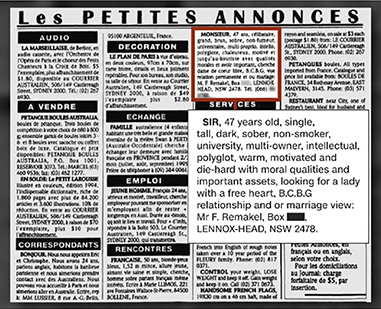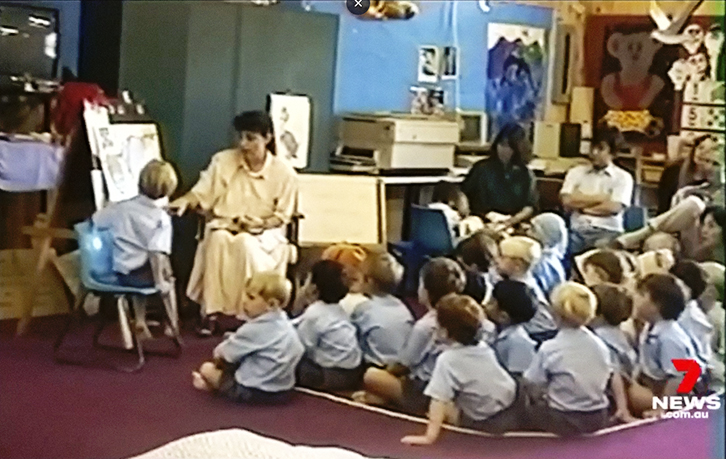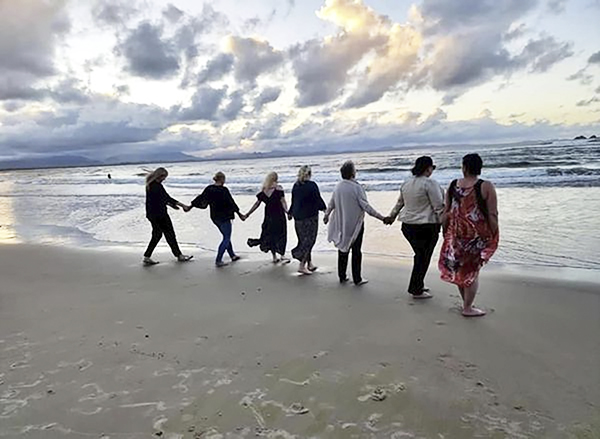On February 29, 2024, New South Wales coroner Teresa O’Sullivan ruled that Marion Barter is likely deceased.
O’Sullivan also noted that while she could not make a finding about the place, cause or manner of Marion’s death, she recommends that the NSW police commissioner ensure’s that Marion’s case is either referred to or remains within the “unsolved homicide team” for ongoing investigation.
Furthermore, O’Sullivan did not recommend charges against Marion’s former lover Ric Blum but she did say that she was “convinced” that Ric “does indeed know more,” and he without a doubt “exploited” Marion right before her death.
The Weekly interviewed Marion’s daughter Sally Leydon and also investigated Marion’s disappearance ourselves last year, and the following article appeared in our May 2023 issue.
In the past four years, there has been a great unravelling in the story of Marion Barter, one of Australia’s most troubling, and now most famous, missing persons cases. For 22 years, the clues had made no sense.
Marion’s daughter, Sally Leydon, had gone over and over the fragments of information her mother had left behind, but everywhere she’d turned doors had closed in her face.

Marion might have remained another forgotten missing woman had her daughter not persevered and refused to forget her. But Sally could never have imagined – none of us could – what would be uncovered when she was joined in her search by a group of doggedly determined amateur sleuths.
I first wrote about the baffling mystery of Marion’s disappearance for The Weekly back in 2010, and again in 2019. Also that year, the Seven Network produced The Lady Vanishes podcast, investigating Marion’s case. It has been downloaded more than 15 million times and ignited the curiosity of people around the world who set out to follow the clues and seek justice for Marion.
Finally, Sally was not alone, but what was discovered – that Marion was probably the victim of a master manipulator and con artist who operated across two continents for decades – was, she says, “beyond comprehension.”
Who was Marion Barter?
Marion Barter was a dedicated teacher at The Southport School on the Gold Coast. “She loved ballet, opera, the finer things of life,” Sally says. At 51, her romantic life had been bumpy. She had been married three times – the first time to soccer star Johnny Warren. Her failed love life was a source of regret. She wanted to be loved.
In March 1997, Marion made a sudden life change. She quit her job, sold her house and announced that she was going on sabbatical to Europe. She became uncharacteristically secretive.
Marion left Australia on June 22, 1997. For a few weeks, she continued to contact her daughter. On August 1, she phoned from Tunbridge Wells and spoke to Sally until she ran out of coins. There was no indication that anything was wrong. She said she missed her. “That was the last time I spoke to my mum,” Sally says.

By October 18, when Marion didn’t contact her son, Owen, for his 23rd birthday, Sally became concerned. She realised she had no idea where her mother was. She contacted Marion’s bank and discovered that over a three-week period in August and September, $5000 a day had been withdrawn in Byron Bay and Burleigh Heads, while her family thought she was in Europe.
On October 15, $80,000 had been electronically transferred to an unknown account. Then Marion vanished. There has been no proof of life since then. Sally reported Marion missing to the Byron Bay police.
The police told her they had spoken to a bank teller who said Marion had talked of starting a new life and didn’t want anyone to know where she was. There is now no police record of this conversation, which would cause two decades of anguish for Sally, who didn’t know whether her mother had inexplicably rejected her family, or met with foul play.
Sally never stopped searching for her mum. Gradually, she pieced together random facts. Years later she learnt that, in May 1997, one month before she’d left Australia, Marion had changed her name by deed poll to Florabella Natalia Marion Remakel.
“For her to change her name is beyond me. I always knew,” she says, “there was a man involved.” But that information didn’t begin to make sense until the sleuths became involved.
Among those whose interest was piqued by The Lady Vanishes podcast was cooking writer and former social worker Joni Condos. Joni was struck by the name Remakel and ran it “through all these active online databases. If you just put ‘Remakel’ in, you would never have got it,” she says. So, she tried putting spaces between the letters in different combinations.

And then she found it: a 1994 lonely hearts ad in Le Courrier Australien, a French-English newspaper. She could hardly breathe. A man called FN Remakel was looking for a “permanent relationship and or marriage”. The ad had a phone number that was linked to a business called Ballina Coin Investments, owned by a couple called Frederick and Diane De Hedervary. Joni has been working almost full-time on Marion’s case ever since.
What happened to Marion?
Based on the information Sally and Joni had uncovered, and 22 years after Sally first reported her mother missing, in 2019, the Unsolved Homicide Unit established Strike Force Jurunga to investigate Marion’s disappearance. Eventually police found a lapsed Queensland driver’s licence in the name of Fernand Remakel that linked to Frederick De Hedervary, and finally led to the man now known as Ric Blum – a man who has changed his name by deed poll 11 times and is known to have used more than 50 aliases.
In February 2022, Blum was called to give evidence at the inquest into the disappearance of Marion Barter in Ballina, NSW. Here, for the first time, Sally came face-to-face with the man who could hold the answers to her mother’s disappearance.
Arriving on a walker, Blum, now 83, appeared befuddled. His hands shook, he muttered obscenities in the corridor, he went off on tangents and took long pauses on the stand. Married and on an invalid pension, he admitted to having an affair with Marion in early 1997, after meeting through a lonely hearts ad, but he insisted they had only seen each other four times.
The coincidences, however, were piling up. According to information presented at the inquest, on June 17 1997, Blum had flown out of Australia under the name of Richard Lloyd Westbury, and on June 22, Marion had left the country. On July 31, Blum had returned to Australia; two days later Marion had returned. On October 14, Blum had opened a safe custody envelope at the Commonwealth Bank in Ballina.
That was one day before $80,000 was electronically transferred from Marion’s bank account. There are no records of where that money went. The safe custody envelope was closed again after 13 days.

Three women also came before the court as witnesses. Each had been middle-aged, vulnerable, divorced and owned property at the time they met Blum. Under a different name each time, he had offered to whisk them away to an exciting new life.
A pattern emerges
Nine months after Marion had disappeared, Ginette Gaffney-Bowen, now 76, met ‘Frederick De Hedervary’ when she placed a newspaper ad looking for companionship after her divorce. “It was a very, very low point in my life,” she told the inquest.
Born in Algeria, Ginette spoke with a thick French accent on a Zoom call to the court. Frederick, she said, had taken her out to dinner and told her he had lost his house. She offered him a studio she had in her garden. He suggested they start a business together, buying and selling old coins. “He said it was an easy business and very rewarding financially.”
Ginette gave him her bank card and pin number to buy a fax machine for the business. He allegedly took $30,000 from her account. A few weeks into the relationship, he started suggesting she sell her house in Sydney. “He said, if I sold my house, he would go to get a beautiful, spacious apartment in Paris. He started manipulating me to sell my house and buy property in France.”
She refused, adamant that her house would go to her children. “He did not like that,” she said. He became angry. He managed to procure nude photos of her (she thinks he might have drugged a glass of wine) and began blackmailing and threatening her.
Valuable items disappeared from her house. “I was becoming very scared and contacted the police,” Ginette said. She took an apprehended violence order out against him. “He was making a living by zeroing in on vulnerable females. He was looking for women who were alone. I believe he could emotionally destabilise as well as financially ruin a person without any care on his part,” she added.

Shown a photograph, she confirmed that ‘Frederick’ was the man now known as Ric Blum.
Janet Oldenburgh, 73, used to attend coin auctions with her husband, Michael, who sometimes bought coins from a man called Rick West. Janet was “shattered” when her husband left her. A year later, in June 1999, she received a phone call from Rick West. “He just appeared out of the blue,” she tells The Weekly.
Janet was lonely, vulnerable and broke. “I was at my lowest and here was someone who cared,” she says. Rick told her he was worth about $12 million and owned 20,000 acres of land. She didn’t tell him when she was granted sole ownership of her home, but three days later, he told her he had feelings for her and asked her to start a fresh life with him on the French Riviera.
“I presumed he loved me because he just seemed so kind and calm and nice and gentle,” she tells The Weekly.
“I didn’t get any feelings of danger from him. I just trusted this guy. I believed everything he said. I was very naive.”
Even when he changed his name by deed poll to ‘Rich Richard’ and suggested she dye her hair for her passport photo, she didn’t suspect anything.

He arranged for them to sign each other’s Power of Attorney. She signed over hers without legal advice; he did not provide his. He buried her jewellery in the backyard, in case the house was burgled in their absence. When they left Australia, on December 2, 1999, he was carrying her complete identity in a small tapestry bag – title deeds to her house, her birth certificate, Australian citizenship, marriage certificate, Power of Attorney, as well as her house keys. He bought her a one-way ticket. He had return tickets.
Janet and ‘Rich’ flew from Bali to Amsterdam, then travelled across the UK to the same places that Marion’s postcards to her family had come from, including a village near Tunbridge Wells, where Blum and his wife, Diane, had lived in the early ’80s. They rarely left their budget hotel rooms and did no sightseeing.
“He did all the organising,” Janet told the coroner.
“He was convincing, smooth, logical. I believed everything he said. I was very naive.”
In Dover, ‘Rich’ suddenly told her he had to go to France on business and sent her to stay with her cousin in Manchester. He gave her enough money for the train ticket but no more. On December 15, he phoned, telling Janet a story about being robbed and beaten by six guys with baseball bats, and that he was in hospital in Lille with broken ribs. His passport and all her documents had been stolen, he said, along with her house keys.
He added that he couldn’t get her a return flight home for weeks.

Realising something was amiss, Janet’s cousin gave her money to fly home, and Janet arrived at her house early on the morning of December 20. A locksmith arrived at 11am, and so did ‘Rich’ wearing a baseball cap pulled low. “The expression on his face was shock,” Janet told the coroner. He had no visible bruises or injuries. After that, she says, “I just didn’t want to trust anybody.”
She identified the man from a photo as Ric Blum.
A twist in the Marion Barter case
In a breathtaking twist to the case, the coroner also heard that Blum had a relationship with a woman called Monique Cornelius in Luxembourg in the early ’80s. His florid letters to her were read out in court.
He’d told her he was a special agent for the British government and wanted to sail off with her into a new life. While he was at it, it was submitted, he had stolen her ex-husband, Fernand Remakel’s, identity.
“To me,” she said, “he is a very big and dangerous manipulator.”
In court, Blum denied most of the allegations by Ginette and Janet: “I never took advantage of anyone, my God.”

In a police interview he also denied murdering Marion Barter. “Are you kidding?” he said. He denied having any interaction with her after they returned to Australia in 1997, and insisted he didn’t know her whereabouts. But by then, Marion’s story had been picked up by journalists in Belgium and Luxembourg.
Alexandra Peereboom recognised Blum and contacted journalists Tom Rudell and Yannick Lambert at the Luxembourg Times. She said what had happened to her mother-in-law, Ghislaine Dubois-Danlois, “was very brutal”.
Ghislaine, who is now in her 80s, was widowed at the age of 50 and brought her four children up almost alone. “I am not stupid,” she told the journalists. “I never have been.” But she was lonely and had placed a small ad in a local paper in 2006. She received a lot of replies but a long, inspirational letter with beautiful handwriting stood out.
“He wanted to marry me in Bali and from there emigrate to Australia,” she told the journalists. “There would be a big house and he had good job running a bank.” He understood, she said, “that my love for my four children was my weakness. He told me that with my money he would open an Australian account for each of my children because they would surely come to visit us.”
Alexandra “couldn’t believe how fast it unfolded”. Ghislaine trusted him, sold her car and house, and liquidated her bank accounts. Within weeks, Blum, known to her as ‘Frederick de Hedervary’, had walked out of her house with her life savings of €70,000 and her most valuable possessions.
“He never threatened me directly, but I was afraid of him,” she says. When he failed to show up for one last family dinner before they flew to Australia, she realised she had been swindled.

Blum did not only swindle strangers. In 2012, a woman who wants to be known as ‘Charlotte’, a Belgian widow and grandmother, received a visit from her deceased husband’s cousin, the man now known as Ric Blum. “He was very friendly and helpful,” she says. “He suggested I travel. I was 61 and widowed, and why wouldn’t I go on vacation with a relative?”
He wanted them to buy a house in Bali, splitting the purchase price of €200,000. She went to the bank and withdrew her share, giving him the cash. In Bali he booked her into a wellness program, went to a business meeting and did not return. She was left in Bali penniless. Family members gave her the money to fly home, where she found valuable jewellery and stamp and coin collections were missing.
Sally and the sleuths believe that more women were conned by Ric Blum using one of his aliases. Sally hopes that articles like this will encourage them to come forward.
The revelations, she says, have been like a “giant roller-coaster”. That her trusting, sweet mother could have fallen for a man like this “was kind of a weird feeling because I then knew my mum wasn’t the only one … It broke my heart to wonder what in God’s name my mum got herself into? … I’m just trying to keep my head above water. I’m very lucky to have people in my corner who understand my anguish.”
Sally still doesn’t know what happened to her mother but her persistence has brought to light the devastating trail of a conman and thief who has caused suffering to victims on two continents.
Marion Barter will never be forgotten by her daughter. “Millions of people know who she is now, which is amazing,” she says. “And the end game is to find her.”



